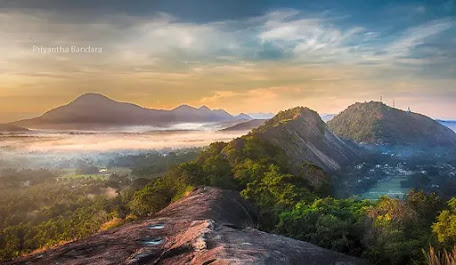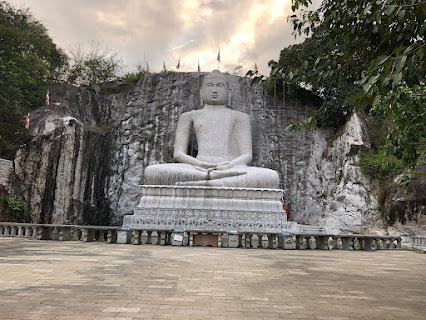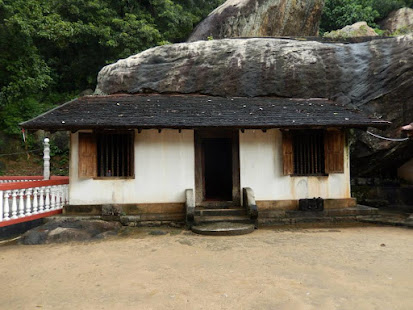Ridi Viharaya
Ridi Viharaya (Sinhala: රිදී විහාරය) or Silver Temple is a 2nd-century BCE Theravada Buddhist temple in the village of Ridigama, Sri Lanka. Built during the reign of Dutthagamani of Anuradhapura, the temple is considered as the place where the silver ore, which provided silver to complete Ruwanwelisaya; one of the largest stupa in Sri Lanka, was discovered. According to the chronicles Mahavamsa and Thupavamsa, the Ridi Viharaya complex was built in gratitude for helping him cherish his dream of completing Ruwanwelisaya.
Approximately 18 kilometres northeast of Kurunegala, Ridi Viharaya is located in Ridigama. Kurunegala is located 94 kilometres northeast of Colombo, the capital of Sri Lanka. The temple is approximately 10 kilometres from Ibbagamuwa, in the A6 highway, which connects Kurunegala and Dambulla.
Yapahuwa (Sinhalese language : යාපහුව) was one of the ephemeral capitals of medieval Sri Lanka. The citadel of Yapahuwa lying midway between Kurunagala and Anuradhapura was built around a huge granite rock rising abruptly almost a hundred meters above the surrounding lowlands.
In 1272, King Bhuvenakabahu transferred the capital from Polonnaruwa to Yapahuwa in the face of Dravidian invasions from South India, bringing the Sacred Tooth Relic with him. Following the death of King Bhuvenakabahu in 1284, the Pandyans of South India invaded Sri Lanka once again, and succeeded in capturing Sacred Tooth Relic. Following its capture, Yapahuwa was largely abandoned and inhabited by Buddhist monks and religious ascetics.
The rock fortress complex of Yapahuwa is situated in the North Western Province, Sri Lanka. It is located approximately between southeast of Mahawa midway Kurunegala and Anuradhapura. The original name of this Buddhist Heritage is Yapawwa but now it is called as Yapahuwa which is a kind of distortion of its genuine etymological sense.
Yapahuwa served as the capital of Sri Lanka in the latter part of the 13th century (1273–1284). Built on a huge, 90 m (300 ft) high rock boulder in the style of the Sigiriya rock fortress, Yapahuwa was a palace and military stronghold against foreign invaders.
The palace and fortress were built by King Buvanekabahu I (1272–1284) in the year 1273. Many traces of ancient battle defences can still be seen, while an ornamental stairway, is its biggest showpiece. This staircase is a long one with around 100 steps. On top of the rock are the remains of a stupa, a Bodhi tree enclosure, and a rock shelter/cave used by Buddhist monks, indicating that earlier this site was used as a Buddhist monastery, like many boulders and hills in the area. There are several caves at the base of the rock. In one of them there is a shrine with Buddha images. One cave has a Brahmi script inscription. At the southern base of the rock there is a fortification with two moats and ramparts. In this enclosure there are the remains of a number of buildings including a Buddhist shrine. There is also a Buddhist temple called Yapahuwa Rajamaha Vihara built during the Kandyan period.
The Tooth Relic was brought from Dambadeniya and kept in the Tooth Temple built for the purpose at the top of the third staircase. The relics were carried away from the temple here to South India by the Pandyas, and then recovered in 1288 by Parakkramabahu III (1287–1293), who temporarily placed them in safety at Polonnaruwa.
The plates also state that the prince Pussadeva later became a monk under Mahadeva Thero and reached the level of an Arhath and that this temple was visited by Maliyadeva Thero who is considered the last Arhath of Sri Lanka.
On a rock surface near the stupa, a large inscription can be seen. Unfortunately, this massive 33×1 meter inscription is so decayed nothing has been read. But to carve out such a large inscription, this temple must have had a very important place in history.
Athkanda Raja Maha Viharaya also known as Ethkanda Viharaya is a Buddhist temple placed in the Kurunegala city in Kurunegala District, Sri Lanka. It is believed that this temple was built in the Dambadeniya era during 14-15 centuries.
About the destination
The history of the establishment of Athkanda Viharaya is obscure. However, a name similar to this temple has been recorded in several chronicles in the country which include Mahavamsa, Sahassavattuppakaranaya, Saddharmalankaraya, Rasavahini, and Vamsattappakasini. According to the information given in Mahavamsa, it’s
assumed that this temple may have been established during the reign of King Suratissa. This temple is believed to have received the royal patronage of prince Buvanekabahu and Bosat Vijayabahu at some stage in
the Dambadeniya period. The Asgiri Thalpatha is famous because the Buddhist monks who had been touring to Kandy in the arrangements made by King Parakramabahu IV (c.1305-1326 A.D.) had been accommodated at Athkanda Vihara in Kurunegala till king’s officials were capable of taking them to Asgiri monastery at Senkadagala. Also, a few statistics referred to as Thalkola Seetu offer some information about the temple and its in- charge monks during the 18-19th century A.D.
Folklore of the destination
Locals consider that the Jathaka testimonies were composed in a cave in this historic temple. This local belief is pinned through the Korawakgala (the balustrade) at the entrance of the cave temple no. 1 in which a unique.


.jpg)
.jpg)
.jpg)
.jpg)
.jpg)
.jpg)
.jpg)

.jpg)

.jpg)




.jpg)
.jpg)
.jpg)
.jpg)
.jpg)
.jpg)
.jpg)











.jpeg)
.jpeg)
.jpeg)










.jpg)


.jpg)



.jpg)
.jpg)





.jpg)


.jpg)



















